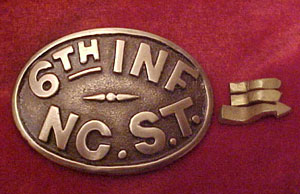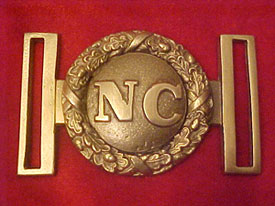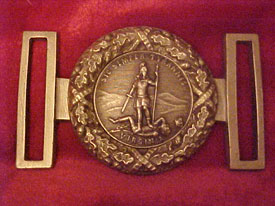Making History: The Civil War Reproductions of Hanover Brass
 6th Infantry North Carolina State Troops Belt Plate.
6th Infantry North Carolina State Troops Belt Plate.Photograph courtesy of Gary Williams
One morning, more than 100 years after Lee's death, Gary Williams stood in his shop holding Lee's buckle. For more than 40 years, Williams has been the proprietor of Hanover Brass Foundry, a company that reproduces original belt plates from the era of the American Civil War, and sells them to collectors and museums. That day, Lee's buckle was on loan from the Museum of the Confederacy in Richmond, VA, located about 25 minutes from Williams' home in Mechanicsville, on the route of Virginia's Civil War Trail.
Carefully, Williams pressed both sides of Lee's belt plate into a cask full of sand, creating an imprint that would serve as the mold for his piece. Nearby, a small forge was heating a container full of molten brass to 2200 degrees. Williams removed Lee's buckle, closed the mold, and with a pair of long tongs grasped the cup of molten metal, pouring it quickly into the cavity his imprint had created. In a few hours, when the brass had cooled, he would grind it, polish it, and clean it. The resulting buckle was virtually indistinguishable from Lee's original. History had been reproduced.
 G-70 North Carolina Two Piece Belt Plate.
G-70 North Carolina Two Piece Belt Plate.Photograph courtesy of Gary Williams
For the residents of central Virginia, the Civil War is hardly a thing of the past. Williams himself lives near the site of the Battle of Cold Harbor, where on June 3 of 1864 Union soldiers charged a well-fortified Confederate line. By day's end, more than 7000 had died. For most Americans such battles are merely the stuff of textbooks, but for Williams they're as real as his own backyard.
For 55 years, Williams has been a hunter of civil war relics, striking out into the woods with his 38-inch "deep seeker" metal detector, tracing old trench lines and hoping to stumble upon scraps that soldiers left behind. Because of a hearing problem brought on by the high-pitched beeping of his detector, Williams couldn't talk on the phone for this story. But according to his website, he has dug over 1200 US belt plates from the battlefields since 1955.
And colleagues and family members alike say his passion for reproducing civil war buckles is born out of the joy he gets from finding them himself.
"Gary is a relic hunter at heart," says his wife, Theresa Williams, a retired educator of 30 years. "Some hunters really like to find ammunition or other things, but his passion is belt buckles. The buckles are so beautiful, and they're very scarce. Eventually Gary figured that rather than having to find them, why not make them himself?"
According to Mrs. Williams, the same passion for history that drives her husband drove their mutual attraction when then met, more than 40 years ago, at a Civil War relic show in Atlanta. At the time, she said, Williams was mainly selling buckles to fellow relic hunters, to support his own hunting habit.
 Solid Brass Reproduction by Hanover Brass Foundry of J. E. B. Stuart Belt Plate.
Solid Brass Reproduction by Hanover Brass Foundry of J. E. B. Stuart Belt Plate. Photograph courtesy of Gary Williams
Once they were married, "I suggested that he make it into a bigger business," she says. "We advertised in a couple of Civil War magazines, and did a mail order catalog for his buckles."
Over time, that evolved into a storefront in a shopping complex in Williamsburg, VA, where Williams demonstrated his buckle-making process and sold his wares. He soon opened a small civil war museum near the shop, to display the thousands of items he had collected over years of relic hunting.
The buckles that Williams reproduces were a vital part of the average soldier's wardrobe both before and during the Civil War. And as soldiers changed-from members of private, local militias to foot soldiers in a national conflict-the buckles changed with them.
In the years leading up to the war, private militias of 50 to 100 men often provided security for particular cities, regions, or states. To identify themselves, they designed their own uniforms, often including ornate and artistic belt buckles that featured detailed lettering and agricultural or military scenes. The scene depicted on Robert E. Lee's buckle is also the Virginia state seal, and it exemplifies the style of these pre-war buckles.
"The ornamental uniforms really came out of the Napoleonic Wars," said Mike O'Donnell, a civil war historian and co-author of the book "American Military Belt Plates," and many other works on civil war relics. "Americans imitated the dress of the French and the British, and their flashy uniforms really embodied the glory of war," he said. "As the Civil War developed, many of the local companies started getting organized into regiments, and the belt buckles were a way for the soldiers to display their identity."
 Solid Brass Reproduction by Hanover Brass Foundry of General Robert E. Lee's Belt Plate.
Solid Brass Reproduction by Hanover Brass Foundry of General Robert E. Lee's Belt Plate. Photograph courtesy of Gary Williams
As the war dragged on, though, time and resources became increasingly scarce for both sides, and the buckles got more generic. Confederate soldiers wore buckles emblazoned with C.S.A. for "Confederate States of America," while the buckles of northern soldiers simply read "U.S."
The color of buckles also changed. In the early years of the conflict, until about 1863, the south was importing zinc from overseas for belt plates, and combining it with locally mined copper to create yellow brass, a light colored alloy that contains about 33 percent zinc.
As zinc became scarcer, red brass (at least 80 percent copper) grew more common, and buckles from this later period are characterized by their reddish tinge. They are also much less uniform in their makeup and appearance than pre-war buckles.
"A lot of times, buckle makers melted down stuff they already had to make buckles," says Tim Parsely of Parsley's Brass, another reproducer of Civil War buckles located in Hanover, VA. "Especially near the end of the war, they were more concerned with getting something out of it than with the precise way it looked."
As a result, collectors consider the pre-war buckles with individual state insignias to be far more valuable than the buckles from the later part of the war.
"Union state buckles are collectable at a high price, and Confederate state buckles can give you a down payment on a house or buy you a car," says Williams. "It's because they are so rare."
Today, Williams has closed his retail shop and mostly sells his buckles through the mail, to collectors and civil war aficionados.
"He used to sell a lot to the Civil War re-enactors," says Theresa Williams, "but I think he pretty much saturated that market."
Many of Williams' current clients, she said, seem motivated by the same love of history that has kept him hunting relics for 55 years. "He sells to a lot of people interested in their ancestry who find out that their grandfather fought in the civil war, and want the same belt buckle he was wearing at the time," she says. "It's pretty exciting to think that soldiers were once marching around the places we live now."
Resources:
Also in this Issue:
- Making History: The Civil War Reproductions of Hanover Brass
- Nothing Fishy: The Copper Work of R. Hanes Hoffman
- Cincinnati Art Museum Welcomes New Bronze Sculpture
- Grace Gunning: Capturing Time, Box by Box
- Winged Camel Metalworks: Functional Copper Artwork with Unique, Whimsical Figures
